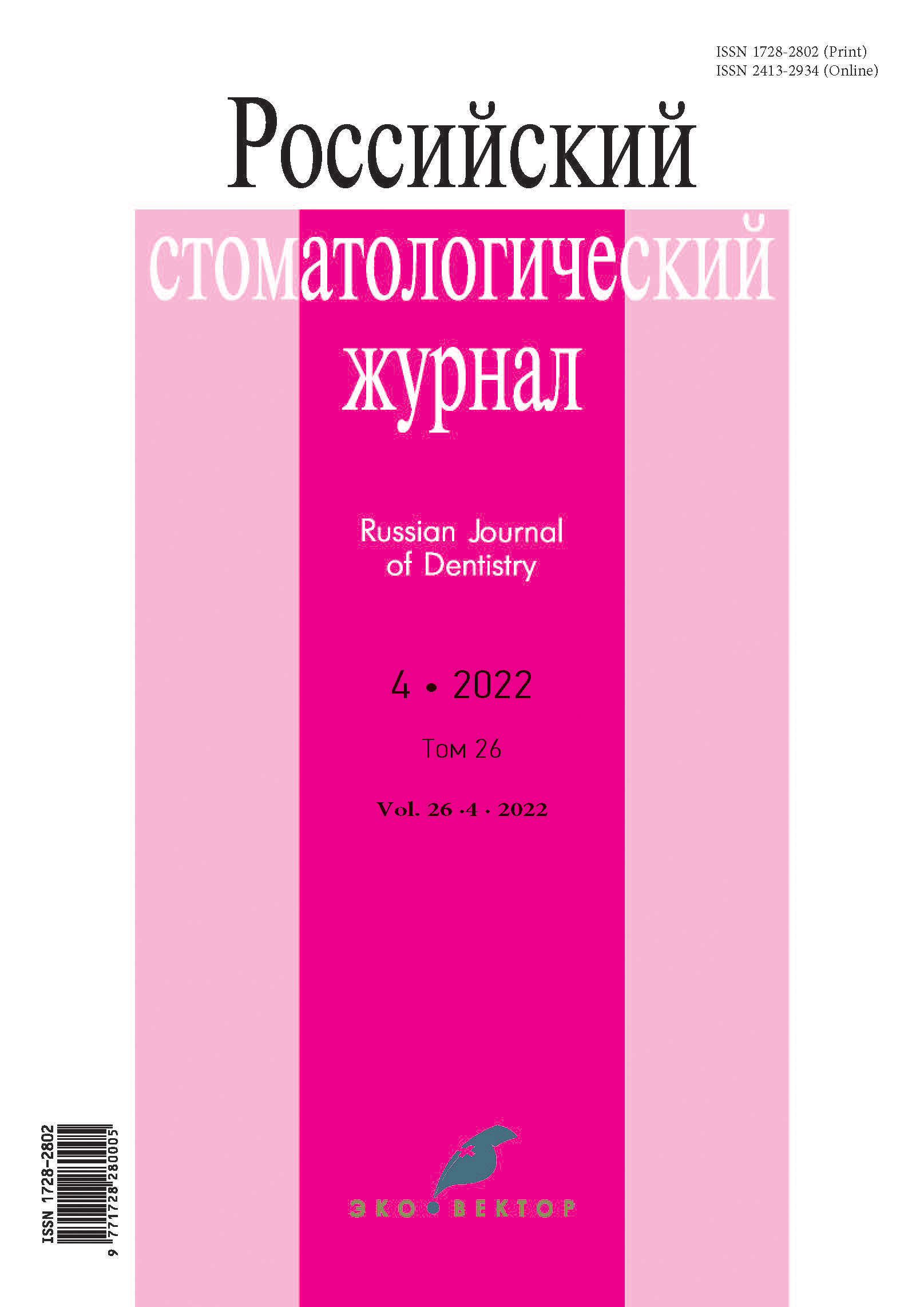Роль мотивации в успешности ортодонтического лечения подростков
- Авторы: Солдатова Л.Н.1,2, Сачиян Ю.В.2, Прохорова В.В.1,3
-
Учреждения:
- Первый Санкт-Петербургский государственный медицинский университет имени академика И.П. Павлова
- Стоматологическая клиника «Альфа-Дент»
- Стоматологическая клиника «Белая Медведица»
- Выпуск: Том 26, № 4 (2022)
- Страницы: 345-353
- Раздел: Клинические исследования
- Статья получена: 15.07.2022
- Статья одобрена: 19.07.2022
- Статья опубликована: 29.09.2022
- URL: https://rjdentistry.com/1728-2802/article/view/109366
- DOI: https://doi.org/10.17816/1728-2802-2022-26-4-345-353
- ID: 109366
Цитировать
Полный текст
Аннотация
Актуальность. Ортодонтическое лечение — длительная и ответственная терапия, влияющая на качество жизни пациента в любом возрасте. Наиболее подходящим для устранения зубочелюстных аномалий и одним из самых непростых с точки зрения психологии является подростковый возраст. Для достижения быстрых и успешных результатов лечения врачу — стоматологу-ортодонту необходимо установить доверительный контакт с пациентом с учетом возрастных особенностей поведения, знать и применять не только современные методы ортодонтического лечения, но и психологические приемы воздействия.
Цель — изучить роль мотивационной активности пациентов подросткового возраста в успешности ортодонтического лечения.
Материал и методы. В исследовании принял участие 51 пациент (28 девочек и 23 мальчика) в возрасте от 12 до 16 лет, проходящий ортодонтическое лечение на съемной и несъемной ортодонтической аппаратуре, разделенный на две группы. В первую группу вошли пациенты с положительной динамикой, соответствующей запланированным срокам лечения, с хорошей гигиеной полости рта и ответственным ношением дополнительной аппаратуры, позитивно настроенные на продолжение лечения. Во вторую группу — пациенты, отстающие по срокам лечения, с плохой гигиеной полости рта, не проявляющие интереса к своему лечению. Наблюдение за пациентами осуществлялось в течение всего срока ортодонтического лечения.
Результаты. Проведенное исследование показало, что успешность ортодонтического лечения пациентов-подростков зависит от их добровольного принятия решения о начале лечения, эмоциональной готовности к нему, доверительных отношений между пациентом, родителями и врачом — стоматологом-ортодонтом. Необходимо учитывать предпочтения подростка при выборе лечебной аппаратуры, более подробно разъяснять необходимость своевременного ортодонтического лечения.
Заключение. Подростки, у которых отмечается высокая мотивационная активность, ответственно подходят к лечению, могут справляться с поставленными перед ними задачами без дополнительного контроля со стороны родителей или врача — стоматолога-ортодонта, не имеют осложнений и своевременно завершают ортодонтическое лечение.
Полный текст
Об авторах
Людмила Николаевна Солдатова
Первый Санкт-Петербургский государственный медицинский университет имени академика И.П. Павлова; Стоматологическая клиника «Альфа-Дент»
Автор, ответственный за переписку.
Email: slnzub@gmail.com
ORCID iD: 0000-0002-4359-2179
д-р мед. наук, доцент
Россия, г. Санкт-Петербург; г. Санкт-ПетербургЮлия Владимировна Сачиян
Стоматологическая клиника «Альфа-Дент»
Email: julez12@mail.ru
Россия, г. Санкт-Петербург
Виктория Валерьевна Прохорова
Первый Санкт-Петербургский государственный медицинский университет имени академика И.П. Павлова; Стоматологическая клиника «Белая Медведица»
Email: prohorovaviktorii@gmail.com
ассистент
Россия, г. Санкт-Петербург; г. Санкт-ПетербургСписок литературы
- Леонтьев В.К. О связи протезирования в стоматологии, уровня здоровья и качества жизни пациентов // Зубной протез и здоровье: сборник научных работ по материалам науч.-практ. конференции. Москва: МГМСУ, 2004. С. 19.
- Иорданишвили А.К., Сериков А.А., Солдатова Л.Н. Зубочелюстные аномалии и патология височно-нижнечелюстного сустава, их синергизм и проблемы военного здравоохранения // Ортодонтия. 2020. № 4 (92). С. 3–7.
- Arunakul M., Kuphasuk Y., Boonyathanasit R. Effectiveness of oral hygiene instruction media on periodontal health among hearing impaired children // Southeast Asian J Trop Med Public Health. 2012. Vol. 43, N 5. P. 1297–1303.
- Обухова Л.Ф. Возрастная психология. Москва: Юрайт, 2014. 442 с.
- Психология современного подростка / под ред. Д.И. Фельдштейна. Москва: Педагогика, 1987. 240 с.
- Аверин В.А. Психология детей и подростков. 2-е изд. Санкт-Петербург: Михайлов В.А., 1998. 379 с.
- Райс Ф. Психология подросткового и юношеского возраста. Санкт-Петербург: Питер, 2012. 816 с.
- Кле М. Психология подростка. Москва: Педагогика, 1991. 176 с.
- Крайг Г., Бокум Д. Психология развития. 9-е изд. Санкт-Петербург: Питер, 2005. 940 c.
- Филонов Л.Б. Психологические аспекты установления контактов между людьми. Методика контактного взаимодействия. Препринт. Пущино: НЦБИ АН СССР, 1982. 40 c.
- Люшер М. Цветовой личностный тест. Минск: Харвест, 2007. 448 с.
- Jin E.Y., Daly B. The self-reported oral health status and behaviors of adults who are deaf and blind // Spec Care Dentist. 2010. Vol. 30, N 1. P. 8–13. doi: 10.1111/j.1754-4505.2009.00113.x
- Улитовский С.Б. Гигиена в ортодонтии. Санкт-Петербург: Человек, 2012. 152 с.
- Солдатова Л.Н., Зуйкова М.А., Иорданишвили А.К., Солдатов В.С. Поддержание стоматологического здоровья детей, проходящих ортодонтическое лечение на миофункциональных аппаратах // Стоматология детского возраста и профилактика. 2019. Т. 19, № 1. С. 76–80. doi: 10.33925/1683-3031-2019-19-69-76-80
Дополнительные файлы














